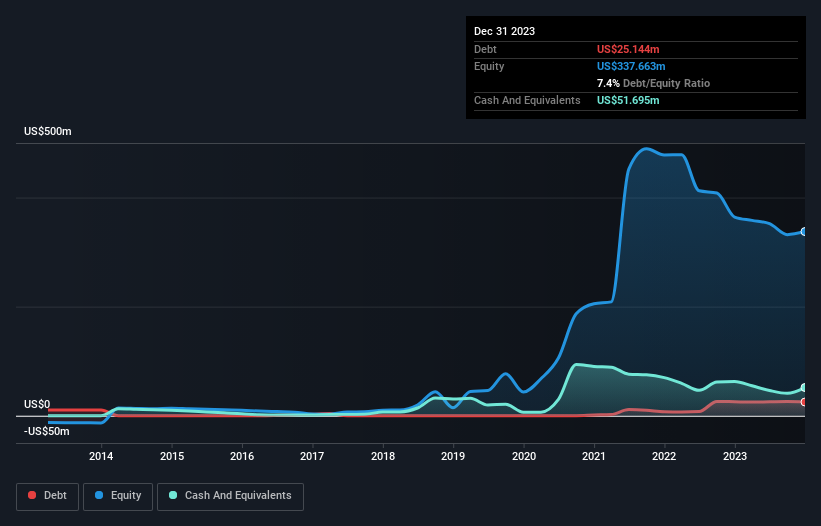- United States
- /
- Life Sciences
- /
- NasdaqCM:BLFS
Does BioLife Solutions (NASDAQ:BLFS) Have A Healthy Balance Sheet?
Some say volatility, rather than debt, is the best way to think about risk as an investor, but Warren Buffett famously said that 'Volatility is far from synonymous with risk.' So it might be obvious that you need to consider debt, when you think about how risky any given stock is, because too much debt can sink a company. As with many other companies BioLife Solutions, Inc. (NASDAQ:BLFS) makes use of debt. But should shareholders be worried about its use of debt?
What Risk Does Debt Bring?
Generally speaking, debt only becomes a real problem when a company can't easily pay it off, either by raising capital or with its own cash flow. Part and parcel of capitalism is the process of 'creative destruction' where failed businesses are mercilessly liquidated by their bankers. However, a more common (but still painful) scenario is that it has to raise new equity capital at a low price, thus permanently diluting shareholders. Of course, debt can be an important tool in businesses, particularly capital heavy businesses. When we think about a company's use of debt, we first look at cash and debt together.
Check out our latest analysis for BioLife Solutions
What Is BioLife Solutions's Debt?
As you can see below, BioLife Solutions had US$25.1m of debt, at December 2023, which is about the same as the year before. You can click the chart for greater detail. But on the other hand it also has US$51.7m in cash, leading to a US$26.6m net cash position.

How Strong Is BioLife Solutions' Balance Sheet?
Zooming in on the latest balance sheet data, we can see that BioLife Solutions had liabilities of US$42.2m due within 12 months and liabilities of US$32.9m due beyond that. On the other hand, it had cash of US$51.7m and US$18.7m worth of receivables due within a year. So it has liabilities totalling US$4.70m more than its cash and near-term receivables, combined.
Having regard to BioLife Solutions' size, it seems that its liquid assets are well balanced with its total liabilities. So while it's hard to imagine that the US$769.2m company is struggling for cash, we still think it's worth monitoring its balance sheet. While it does have liabilities worth noting, BioLife Solutions also has more cash than debt, so we're pretty confident it can manage its debt safely. When analysing debt levels, the balance sheet is the obvious place to start. But ultimately the future profitability of the business will decide if BioLife Solutions can strengthen its balance sheet over time. So if you're focused on the future you can check out this free report showing analyst profit forecasts.
In the last year BioLife Solutions had a loss before interest and tax, and actually shrunk its revenue by 11%, to US$143m. We would much prefer see growth.
So How Risky Is BioLife Solutions?
By their very nature companies that are losing money are more risky than those with a long history of profitability. And we do note that BioLife Solutions had an earnings before interest and tax (EBIT) loss, over the last year. Indeed, in that time it burnt through US$24m of cash and made a loss of US$66m. However, it has net cash of US$26.6m, so it has a bit of time before it will need more capital. Overall, we'd say the stock is a bit risky, and we're usually very cautious until we see positive free cash flow. There's no doubt that we learn most about debt from the balance sheet. However, not all investment risk resides within the balance sheet - far from it. These risks can be hard to spot. Every company has them, and we've spotted 1 warning sign for BioLife Solutions you should know about.
At the end of the day, it's often better to focus on companies that are free from net debt. You can access our special list of such companies (all with a track record of profit growth). It's free.
Valuation is complex, but we're here to simplify it.
Discover if BioLife Solutions might be undervalued or overvalued with our detailed analysis, featuring fair value estimates, potential risks, dividends, insider trades, and its financial condition.
Access Free AnalysisHave feedback on this article? Concerned about the content? Get in touch with us directly. Alternatively, email editorial-team (at) simplywallst.com.
This article by Simply Wall St is general in nature. We provide commentary based on historical data and analyst forecasts only using an unbiased methodology and our articles are not intended to be financial advice. It does not constitute a recommendation to buy or sell any stock, and does not take account of your objectives, or your financial situation. We aim to bring you long-term focused analysis driven by fundamental data. Note that our analysis may not factor in the latest price-sensitive company announcements or qualitative material. Simply Wall St has no position in any stocks mentioned.
About NasdaqCM:BLFS
BioLife Solutions
Develops, manufactures, and markets bioproduction products and services for the cell and gene therapy (CGT) industry in the United States, Europe, the Middle East, Africa, and internationally.
Excellent balance sheet with reasonable growth potential.
Similar Companies
Market Insights
Community Narratives



